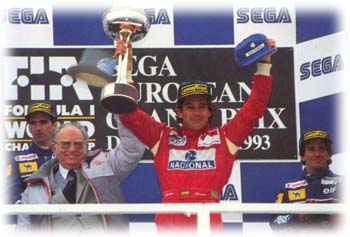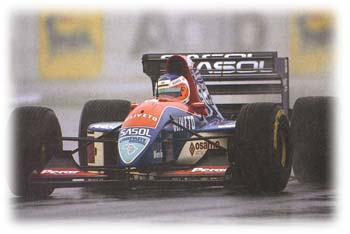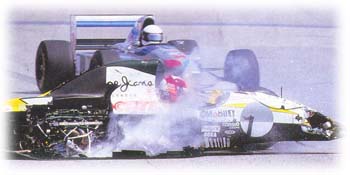 |
The Races we Remember: the Specials of the 90s |
| Selected and narrated by Michele Lupini, South Africa |
|
|
As the first 50 years of the Formula One come to an end, Atlas F1 looks back at the ten most memorable races of the World Championship - two races from every decade. They were the best of times; they were the worst of times. These are the events that enriched our lives, left their mark and will forever be a part of racing heritage, for years to come
For me, there were many great races of the nineties. To choose two is difficult, especially since in terms of significance, the horror of Imola 1994 was clearly the most striking F1 event of the decade. The other has to come from a wet Grand Prix - damp conditions seeming to be the catalyst that makes modern Grand Prix racing more exciting. And of the wet races of the nineties, one stands head and shoulders above the rest...
1993 European Grand Prix, Donington
Winner: Ayrton Senna Second place: Damon Hill Third place: Alain Prost Easter Sunday, 1993, saw the first Grand Prix at Donington since the great Nuvolari won there in 1937. Gloomy conditions saw a small crowd, but the race was a classic. Traction control was the order of the day in 1993, but Donington was set to produce the drive of the decade.
A careful start saw Prost lead away, but Senna quickly shot through the field, re-passing a quick-starting Karl Wendlinger around the outside before snapping up Hill and Prost to lead by the end of the first lap. Senna quickly opened up the lead, but with drying conditions, several drivers pitted for slicks, Brundle quickly exiting after emerging from the pits in the Ligier. As it became drier, Prost and Hill upped the ante, Senna pitted for slicks, the McLaren crew executing a brilliant tyre change to retain the lead despite the Williams' continued pace and a steady flow of backmarkers to deal with. Berger decided it was enough, abandoning the Ferrari in the pits, but the rain started again. Prost immediately stopped for wets again, Schumacher and Blundell had moments, as, it appeared by the marks on his car, did Ayrton, albeit retaining a 12 second advantage over Hill, who soon stopped for wets too. Senna, well clear of Alesi and Barrichello, stayed out until lap 26, but with the wet-shod Prost flying, he elected to stop. Once again, brilliant McLaren pit work saw him retain the lead. Prost took second from Alesi who promptly pitted for wets, leaving Senna easily leading an albeit closing Prost, as Barrichello passed Hill for third. But Damon fought back as the pair diced for the position.
Prost pitted again but stalled, allowing Senna to lap the Frenchman as he re-joined, going on to even further open the gap on second placed Barrichello, the only other driver on the same lap. Ayrton soon lapped him too, before Rubens pitted for slicks. Senna then entered the pits for fresh slicks, but it started to rain and he drove past his box, waving at his crew! He still led a quick Hill and Prost by a lap. Damon un-lapped himself before Senna finally stopped again - this time for wets. He led Hill and Barrichello - set to be the youngest ever driver on the podium - but the Jordan expired to let Prost in for third. Senna won by almost a minute and a half from Hill and a further 35 seconds from Prost. His greatest race, Ayrton Senna did not benefit from any car advantage to win it. Like the great Nuvolari with the Alfa against the might of the silver arrows at the Nurburgring, he used lesser machinery to make the best of trying conditions to beat off the favourites. He read the conditions perfectly to embarrass the entire field - making four stops to Prost's seven. Donington was Ayron's finest hour - he seemed immortal and this race was final proof of his greatness. But immortal, sadly, no one is...
1994 San Marino Grand Prix, Imola
Winner: Michael Schumacher Second place: Nicola Larini Third place: Mika Hakkinen
At the beginning of 1994 everyone predicted that the world championship was a foregone conclusion. After all, who would beat Ayrton Senna in the Williams-Renault? Then, fate intervened. The 1994 San Marino Grand Prix at Imola was about to shock the entire world, let alone Formula One. On Friday afternoon, Rubens Barrichello had a frightening accident in the Jordan, the force of the impact shaking the grid in its violence. Ayrton Senna was concerned at the ferocity of the incident. Then, on Saturday, the amiable Roland Ratzenberger, who had fought his way into F1 and was fighting to qualify the recalcitrant Simtek, lost control and slammed into the wall in another frightening accident. He was killed in the accident.
F1 was shocked - it had not witnessed death for over a decade. One of the most noticeably disturbed by Roland's demise was a very concerned Ayrton Senna. The Grand Prix started under the cloud of that previous day's tragedy, but it wasn't going much better. A massive start-line pile-up saw a wheel flying into the crowd and injuring spectators in the packed grandstand. The weekend was taking on a grim mantle, but the worst was still to come. At the restart, after a few laps following the pace car, Senna led championship leader Schumacher, but as he negotiated the fearsome Tamburello curve, Senna's Williams suddenly veered off course and slammed into the wall. He was killed instantly by a suspension part that pierced his helmet. And all this was happening live, on the TV screens of tens of millions around the world.
The world was stunned. Such was the impact of the accident, that even in South Africa, where that country's first democratic election results were being counted on the same day, Senna's tragic accident was the lead story on local TV news. To add to the confusion, when the race was eventually restarted, a pitlane incident saw a mechanic seriously hurt when a wheel came off an accelerating car. In all, Imola was a weekend F1 will never be allowed to forget. The repercussions were immense, the Senna Trial continuing until just a few weeks ago, haunting F1 all the way. The cars have changed, the circuits have been altered and F1 will never be the same after that tragic weekend, when the balance of the F1 world shifted so significantly. People tend to remember the greatest moments when quizzed about F1's most significant events. Sadly, the nineties cannot be remembered without reflecting on its Black Imola Weekend.
|
| Michele Lupini | © 1999 Kaizar.Com, Incorporated. |
| Send comments to: lupini@atlasf1.com | Terms & Conditions |
All pictures used in the 50th Anniversary issue were kindly provided by Rainer Nyberg | |
 Alain Prost had returned to F1 after a year away and was on track for his fourth world championship. He was on pole again in the Williams - alongside impressive new teammate and relative F1 rookie, Damon Hill. Ayrton Senna, suffering an uncompetitive McLaren Ford, qualified fourth - alongside F1 prodigy, Michael Schumacher's Benetton.
Alain Prost had returned to F1 after a year away and was on track for his fourth world championship. He was on pole again in the Williams - alongside impressive new teammate and relative F1 rookie, Damon Hill. Ayrton Senna, suffering an uncompetitive McLaren Ford, qualified fourth - alongside F1 prodigy, Michael Schumacher's Benetton.
 It was drying again and Prost pitted early for slicks, this combined with a tardy McLaren stop allowed Alain into the lead. Hill had a quick stop, thus allowing Alesi to move up to second and an impressive Barrichello up to third. But it started raining again. Prost pitted, but Senna stayed out, setting a fastest lap in the inclement conditions to lead Alain despite some difficult backmarkers in the gloom, often shaking his fist as he eventually passed them.
It was drying again and Prost pitted early for slicks, this combined with a tardy McLaren stop allowed Alain into the lead. Hill had a quick stop, thus allowing Alesi to move up to second and an impressive Barrichello up to third. But it started raining again. Prost pitted, but Senna stayed out, setting a fastest lap in the inclement conditions to lead Alain despite some difficult backmarkers in the gloom, often shaking his fist as he eventually passed them.
 But after two races, it was Senna 0 to Michael Schumacher's 20.
But after two races, it was Senna 0 to Michael Schumacher's 20.
 That very day, the Grand Prix Drivers Association was refounded, with Senna heading the first meeting, discussing safety measures for the coming race.
That very day, the Grand Prix Drivers Association was refounded, with Senna heading the first meeting, discussing safety measures for the coming race.
 The accident made the front page of Time magazine as the world looked at F1 in shock.
The accident made the front page of Time magazine as the world looked at F1 in shock.